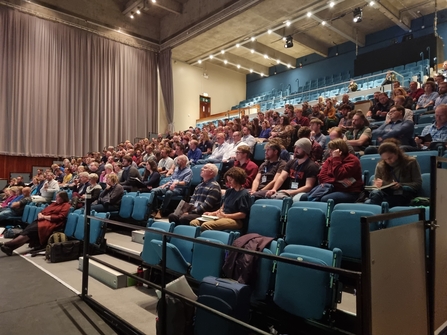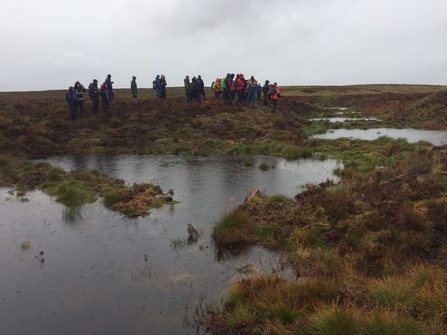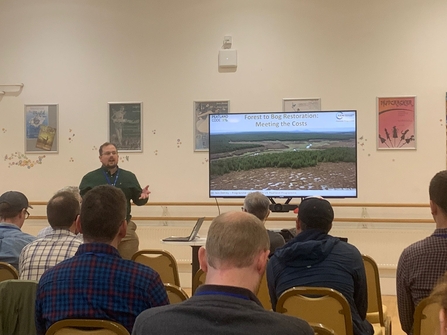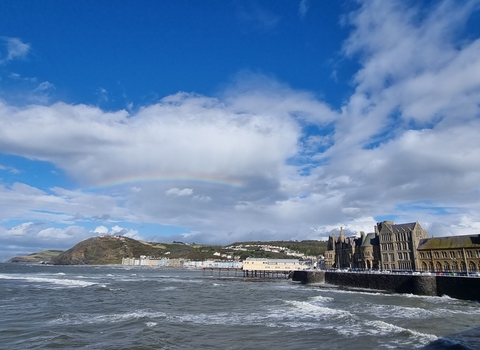In 2022, we were delighted to welcome delegates to Wales for our first in-person conference since 2019. Our theme for this conference focused on how peatland restoration can be delivered at scale, building on the knowledge gained from projects around the UK.
The 2022 conference was delivered in partnership with, New LIFE for Welsh Raised Bogs, Natural Resources Wales National Peatland Action Programme , Natural England's Marches Mosses BogLIFE and Pennine PeatLIFE.
This year’s conference included peatland field trips to various restoration efforts around mid-Wales, workshops for the discussion of problems and solutions across a variety of subjects, opportunities for poster exhibition and oral presentations and networking events including a Twmpath band and dance.

Conference 2022. Credit Emma Hinchliffe
Over 240 local, national and international delegates and volunteers from across sectors came together over 3 days to explore themes including:
- Progress made towards UK Peatland Strategy goals and delivery
- Lowland raised bog restoration - learnings, challenges and legacy
- Forest to Bog restoration - policy and practice
- Moving away from trees
- Peatland monitoring and reporting
- Scaling-up delivery, capacity, skills and finance
This Conference aimed to provide a forum for delegates to explore:
- How we maintain momentum and monitor progress towards the UK Peatland Strategy goals and share experience
- How we can scale up capacity and the speed at which restoration is delivered focusing on skills, finance and working with multiple stake holders across landscapes
- How we advance policy when addressing monitoring and reporting, forest to bog restoration and how to move away from trees or peat to meet both native woodland and peatland restoration targets

Credit Peter Jones
Day 1 speaker presentations
Our conference this year was kindly opened by Julie James MS, Minister for Climate change in the Senedd Cymru. The minster highlighted the role that peatlands have to play as nature-based solutions in addressing the twin crises of biodiversity loss and climate change and announced that, along with her colleagues in government, she had agreed to triple the peatland restoration target in Wales through the Natural Resources Wales National Peat Action Plan (NPAP).
Our welcome was then continued by Clare Pillman, the Chief Executive of Natural Resources Wales. Clare thanked the Minister and the Welsh Government for their commitment to peatlands, nature and a sustainable future and called to end the sales of peat containing products. Clare then went to highlight the significant work of the Welsh LIFE Raised Bogs Project and NPAP and the importance of all the UK peatland Initiatives working collaboratively to achieve our peatland restoration goals.
Below you can find the presentations from Day 1.
UK Strategy Progress – Update
An overview of the UK Peatland Strategy – Emma Hinchliffe (IUCN UK Peatland Programme)
Nation Updates:
England – Sophie Chapman (Defra), Wanda Fojt (Natural England), Katharine Birdsall (Environment Agency)
Northern Ireland – Dave Foster (DAERA)
Scotland – Ben Dipper (Scottish Government)
Wales – James Cooke (Welsh Government), Peter Jones (Natural Resources Wales)
UK Strategy Progress – Delivery at Scale
Welsh National Peatland Action Programme – Rhoswen Leonard (Natural Resources Wales - NPAP)
Royal Society of Wildlife Trusts – Rob Stoneman (Royal Society of Wildlife Trusts)
WaterLANDS project (England, Northern Ireland, Republic of Ireland & Europe) - Craig Bullock (University College Dublin)
Peatland ACTION– Peter Hutchinson (NatureScot)
Global Peatlands Initiative – Dianna Kopansky (United Nations Environment Programme)

Conference 2022 - Four Nation Representatives on Day 1. Credit Drew Buckley
Day 3 discussion sessions
Day three of the conference saw a series of workshops for knowledge exchange and the discussion of issues facing peatland restoration.
Lowland raised bog restoration – learnings, challenges and legacy
Technical Session – Bunding
Bunding has been used extensively as a technique in lowland and upland peatland restoration projects. This session highlighted some examples of bunding being utilised as part of restoration plans, examined their effectiveness, good practice techniques, GHG impact and lessons learned.
Presentations included:
Introduction to the Welsh Raised Bog Resource – Pete Jones and Jake White (NRW & Welsh LIFE Raised Bogs Project)
Peat Bunding on Lowland Mires in North Cumbria – Emma Austin (Cumbria BogLIFE)
Technical session: lowland peatland hydrology (bogs and fens)
Hydrology - both water quantity and quality - is key to restoring and maintaining healthy peatlands. Restoration work is often a compromise between peatland objectives within the site and balancing that with surrounding constraints and pressures in the landscape. This session looked at defining hydrological objectives for lowland bogs and fens including:
- How do we define a workable bog surface datum?
- Restoring the lagg component – can a bog ever be at FCS without one?
- Defining lateral limits – how much of the bog should be favourable M18?
- Landscape scale hydrology in relation to raised bogs
Presentations included:
Investigation of hydrology, vegetation and microtopography on Cors Fochno SAC – Justin Lyons
Forest to Bog restoration – policy and practice
Science and Practice: Emerging restoration techniques and identifying research gaps
This session explored key recent research on forestry and peatlands with examples from both upland and lowland study site, highlighting the latest greenhouse gas data, good practice restoration techniques and how to take into consideration the impact on shallow peat soils.
The discussion explored:
- Carbon emission pathways
- Data gaps and how to plug them
- Restoration objectives carbon/biodiversity/water – timescales and techniques
- Monitoring protocols
Presentations included:
Forestry and Peatlands: Research Updates – Russell Anderson (Forest Research)
Forest to Bog Science and Management in the Flow Country – Rob Hughes (RSPB & ERI-UHI)
Forest to Bog Restoration: Meeting the Costs – Iain Detrey (IUCN UK Peatland Programme)
Forest to Bog Restoration in the Lowlands – Case Study from the Fenn’s and Whixall Mosses NNR – Robert Duff (Natural England)
Restoration Trajectories in Peatland Surface Motion using Satellite Radar – Chris Marshall (ERI-UHI)
Lost Peatlands – Mike Shewring and Joey Pickard (Lost Peatlands)
Moving away from trees OR peat - conversations
Recognising the need for trees and peat as two of our greatest natural carbon ecosystems, how do we deliver objectives for both without compromising one for the other? The session explored:
- Prioritisation of removal of unsuitable plantings. How to marry peat and trees targets?
- New trees and peat guidance: helping to inform where to establish trees and where to restore peat in England
- Delivering the lost trees: upland scrub, hillslope woodland, wet woodlands.
- How do we approach shallow peat?
Presentations Included:
Upland Ecosystem Options: Future Landscapes at a Farm Scale – John Ratcliffe (Specialist Advisor - NRW)
Marrying Peat and Trees Targets – Rachel Chamberlain (NRW)
New Trees and Peat Guidance: Helping to Inform Where to Establish Trees and Where to Restore Peat in England – Mark Owen (Natural England) and Neil Riddle (Forestry Commission)
Planting Trees on Peatlands in Wales: The Rules – Victoria Jenkins (Swansea University)
Approach to Shallow Peatlands – Iain Diack (Natural England)
The Wet Woodlands Research Network: Strengthening the Evidence Base for Wet Woodlands – Alice Milner (Royal Holloway University of London)
Peatland Monitoring and reporting
Coordination and Leadership
This session aimed to capture the range of monitoring which is taking place in peatland across the UK, showcasing multiple examples. Discussions explored:
- Which actors are involved in the monitoring process?
- How to enable a cohesive approach to reporting? Who is taking a leadership/co-ordinating role?
- What targets are being assessed as a result of monitoring?
- How to report progress against strategic objectives at national and UK levels?
- What is needed to meet our international commitments for biodiversity monitoring?
- What data is being gathered and where is it being held?
Presentations included:
Nature for Climate Peatland Grant Scheme: Monitoring the Impacts of Peatland Restoration - Emma Craig (Natural England)
Mapping the Jewels in the Crown of Welsh Peatlands – Kathryn Birch (NRW)
National Peatland Action Plan – Pete Jones (NRW)
Peatland Ecosystem Services Demonstration in NI – Bryan Irvine (DAERA)
Monitoring: Past, Present, Future – Joe Bullard and Lucy Elliff (Peatland ACTION)
Yorkshire’s Eyes are on the Bog – Beth Thomas (Yorkshire Peat Partnership)
Wales Peatland Action: Data Recording, Gathering & Sharing – Esther Clews (NRW-NPAP)
Core outcomes
There is a need for a co-ordinated approach to monitoring and for the community to be measuring the same attributes to allow for cohesive reporting had been discussed. This session focused on how to move towards developing these common standards. Discussions explored:
- Moving towards common standards: Core outcomes work
- What are the priority data gaps?
- What needs more monitoring and why is it useful?
- Who is responsible for identifying data needs and how are strategic data needs communicated to monitoring initiatives on the ground /projects/ academics?
- How is the data best held and made available?
- What more needed in getting consistent monitoring methods, and defining peatland states to inform those doing monitoring/research?
Presentations included:
Core Outcomes and Measures in Peatland Research and Monitoring – Jon Walker (Swansea University)
Monitoring Restoration of Heavily Degraded Blanket Bog in the South Pennines SAC: Trajectories of Ecosystem Change – Tom Spencer (Moors for the Future)
Peatland Monitoring and Reporting: Data Needs and the Peatland Code – Ed Salter (IUCN UK Peatland Programme)
Scaling-up delivery
Capacity and Skills
This session shared experiences from projects as to some of the barriers to delivering peatland restoration at scale, with a focus on the both capacity and skills gaps. Presentations focused on contractor capacity and covered training and education initiatives, engaging contractors and upscaling their capacity for delivery and experiences of managing contractors on large scale projects.
Presentations included:
An ‘Upscaled’ Contractor Base? – Anette Rumble and Rhoswen Leonard (NRW – NPAP)
Training, Skills and Capacity Development – Tessa Levens (Yorkshire Peat Partnership)
Scaling up Finance
This session asked: is the conservation sector ready for private finance? Presenters gave their perspectives on incorporation of private finance initiatives into peatland conservation and restoration. The session covered how the Peatland Code is developing, how it is integrating with other financial mechanisms and gave examples of developing projects. Discussion allowed delegates to feed in their experience of integration private finance; what have been the challenges? Successes? And what is needed in the finance sector to support the future scale of peatland restoration required in the UK?
Presentations included:
The Peatland Code: Key to Delivering Action? – Prysor Williams (Bangor University)
A Practitioner’s Perspective to Implementing the UK Peatland Code – Alistair Lockett (North Pennines National Landscape)
Peatland Code – Renée Kerkvliet-Hermans (IUCN UK Peatland Programme)
Knowledge Exchange
The final room was open to all who wanted to submit a presentation in a less structured format for knowledge exchange. The call for presentations delivered a wide range of topics from stakeholder and community engagement in peatland projects, novel methods of mapping and data collection to the presentation of new science.
Presentations included:
After Revegetation How Do You Justify Continued Investment in Moorland Restoration – Laura Flower (Severn Trent Water)
Bring Stakeholders Together to Collectively Facilitate Positive Management and Restoration of Peatland Habitats – Heinz Traut (Northumbria Peat Parnership)
The Peatland Climate Action Scheme – Mark McCorry (Bord na Móna)
Bogtastic! Bringing the Moors to Communities Around the Region – Robbie Carnegie (Moors for the Future)
Monitoring Peatland Using the Internet of Things – Hazel Mitchell (University of Southampton)
AI for Peatlands – Anne Williams (Forestry Commission)
Sphagnum Moss Provides Resilience in Restoration – Sadie Manning and Andrew Davidson (Beadamoss)

Poster and Exhibition sessions
The Poster and Exhibition sessions welcomed poster presentations and exhibition stands to share knowledge, experience, new findings, tried and tested techniques and novel approaches to peatland research, policy and practice.
The UK is a global leader in peatland restoration. This is only made possible by the enthusiasm and dedication of hundreds of individuals, whether paid staff or volunteers; NGO, Government, academic, business or private land manager. We would like to commend the whole peatland community and particularly the partnerships that drive this work, restoring and protecting peatlands for future generations.
We were delighted to bring the conference to you this year in partnership with New LIFE for Welsh Raised Bogs, Welsh National Peatland Action Programme, Marches Mosses BogLIFE and Pennine PeatLIFE.
The event was kindly sponsored by eftec, Strutt&Parker, Terra Motion, Vattenfall, Salix and Meredith Contract Services.
And with much appreciated support from The Wildife Trusts.


















